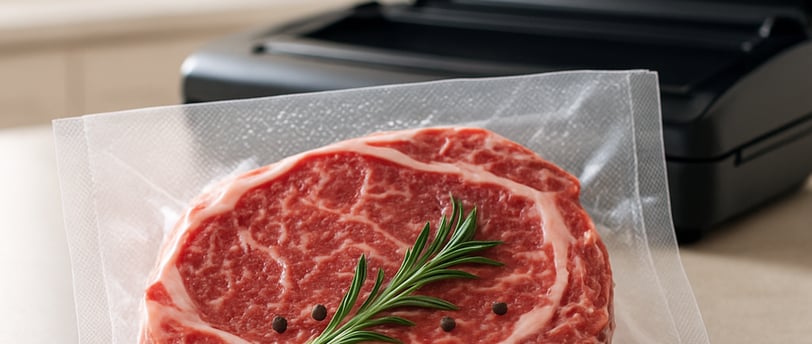Vacuum Sealed Freshness
Talking about the benefits of using a vacuum sealer to prepare your delicious food items before freezing.
KITCHEN
6/9/20252 min read


Vacuum Sealing for Freshness:
The Ultimate Freezing Solution
When it comes to preserving the freshness and quality of your food, vacuum sealing has become a game-changer—especially for those who rely on freezing to extend the shelf life of their favorite ingredients. Whether you’re a home cook, a meal prep enthusiast, or someone who likes to buy in bulk, vacuum sealing offers a host of benefits that make it the gold standard for freezer storage. Please note that this post may include affiliate links from which I may earn a small commission but this is at no cost to you.
Zero Chance of Freezer Burn
One of the most significant advantages of vacuum sealing is its ability to virtually eliminate freezer burn. Freezer burn occurs when air comes into contact with food, causing dehydration and oxidation that result in dry, tough, and flavorless patches. By removing all the air from the packaging, vacuum sealing creates an airtight environment, ensuring that your food stays moist, flavorful, and protected from the harsh conditions of the freezer.
Longer Shelf Life
Vacuum-sealed foods can last two to five times longer in the freezer compared to those stored in traditional packaging. The absence of air slows down the growth of bacteria and mold, keeping your food safe and fresh for months—even years. This means you can stock up on seasonal produce, meats, and prepared meals without worrying about spoilage or waste.
Preserving Taste and Nutrition
Vacuum sealing not only protects food from freezer burn but also helps preserve its original taste, texture, and nutritional value. Because the food is not exposed to air, it retains its natural moisture and flavor, ensuring that every meal tastes as good as the day it was sealed. Nutrients are also better preserved, making vacuum-sealed frozen foods a healthier choice.
Space-Saving and Organization
Vacuum-sealed bags take up less space than bulky containers or loosely wrapped packages, allowing you to maximize your freezer’s capacity. The uniform, flat shape of vacuum-sealed packages makes it easy to stack and organize your freezer, so you can quickly find what you need and reduce food waste.
Convenience and Versatility
Vacuum sealing is incredibly versatile. You can use it for meats, vegetables, fruits, cheeses, and even leftovers. It’s also perfect for sous vide cooking, marinating, and portioning meals for easy weeknight dinners. With a home vacuum sealer, you can take control of your food storage and enjoy fresh, delicious meals any time.
In conclusion, vacuum sealing is the ultimate solution for anyone looking to freeze food without compromising on quality. With benefits like zero chance of freezer burn, longer shelf life, and preserved taste and nutrition, it’s no wonder more people are making the switch. Invest in a vacuum sealer and experience the difference for yourself!
So which type should you get?
There are two main types of vacuum sealers for kitchen use: external (kitchen top style) and chamber vacuum sealers. The kitchen top style, also known as edge or external sealers, are compact and great for everyday tasks like sealing dry foods or prepping ingredients for sous vide. However, they struggle with liquids—soups, sauces, and marinades can get sucked into the machine, making a mess and sometimes ruining the seal. Chamber vacuum sealers, on the other hand, are designed to handle both solids and liquids with ease. Because the entire bag is placed inside the chamber and the air is removed evenly, you can vacuum seal soups, stews, and even marinated meats without any spills. Having used both types, I can confidently say that for anyone who wants to regularly seal liquids or sauces, a chamber vacuum sealer is the way to go for convenience and reliability.
Explore
Discover kitchen tools and recipes from everywhere.
Savor
Cook
Hello@simmerspace.com
© 2025. All rights reserved.